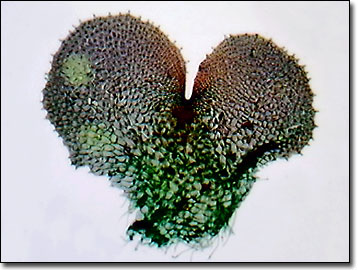Brightfield Digital Image Gallery
Fern Prothallium
Fern is a common name for the cryptogamous (spore-producing) plants belonging to the division Filicophyta, also called Filicinophyta or Pterophyta, of seedless vascular plants. They are primitive vascular plants with true roots, stems, and complex leaves. Most ferns reproduce by alternating generations between successive sexual and asexual forms.

View a medium magnification image of the fern prothallium.
View a high magnification image of the fern prothallium.
The sexual form, called the gametophyte or prothallium, is a tiny kidney-shaped haploid (N) plant that is difficult to find in the wild. The asexual form, or sporophyte, is represented by the commonly known and cultivated fern plant, and is diploid (2N). Sporophytes can reproduce either by vegetative cloning via their rhizomes or through spore formation. The prothallia are equipped with multiple antheridia (male reproductive organs) and archegonia (female reproductive organs). As heterosporous plants, the fern's antheridium produces free-swimming sperm and its archegonium produces eggs. The products of their unions are zygotes, and fertilization occurs when the sperm swim through an opening (operculum) from each antheridium along a thin film of water to the neck of each archegonium. At the same time, the central neck canal cells of the archegonia break down and dissolve, forming canals that permit sperm entry and motility towards the eggs.
The Filicophyta division is diverse, containing about 150 genera and as many as 15,000 species. Fern fossils have been dated to the Lower Devonian Period, 360 million years ago, making them among the oldest vascular plants. Ferns occur throughout the world, but are most profuse in tropical regions where some species grow as epiphytes (air plants) on the trunks and branches of trees. The number and diversity of ferns diminishes with increasing latitude and decreasing moisture, though a few species are found in dry, cold regions.
Contributing Authors
Cynthia D. Kelly, Thomas J. Fellers and Michael W. Davidson - National High Magnetic Field Laboratory, 1800 East Paul Dirac Dr., The Florida State University, Tallahassee, Florida, 32310.
BACK TO THE BRIGHTFIELD IMAGE GALLERY
BACK TO THE DIGITAL IMAGE GALLERIES
Questions or comments? Send us an email.
© 1995-2025 by Michael W. Davidson and The Florida State University. All Rights Reserved. No images, graphics, software, scripts, or applets may be reproduced or used in any manner without permission from the copyright holders. Use of this website means you agree to all of the Legal Terms and Conditions set forth by the owners.
This website is maintained by our
Graphics & Web Programming Team
in collaboration with Optical Microscopy at the
National High Magnetic Field Laboratory.
Last Modification Friday, Nov 13, 2015 at 01:19 PM
Access Count Since September 17, 2002: 27565
Visit the website of our partner in introductory microscopy education:
|
|
